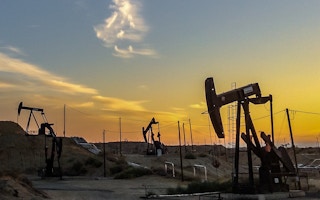Both carbon emissions and the demand for oil globally must fall from this year onwards for global temperatures to be limited to 1.5˚C above pre-industrial levels, long-term scenarios modelled by consultancy Wood Mackenzie suggest.
To continue reading, subscribe to Eco‑Business.
There's something for everyone. We offer a range of subscription plans.
- Access our stories and receive our Insights Weekly newsletter with the free EB Member plan.
- Unlock unlimited access to our content and archive with EB Circle.
- Publish your content with EB Premium.
There is only leeway for greenhouse gases and oil use to climb for one more year to keep global warming under 2˚C, as countries worldwide vowed in the landmark 2015 Paris Agreement.
The analysis released on Thursday comes amid steadily rising fossil fuel demand after the Covid-19 economic downturn, and an exploration drive for oil and gas amid trade fractures caused by the Russia-Ukraine war.
It represents a much steeper decarbonisation pathway than most expect – the head of the International Energy Agency said earlier this week that fossil fuel demand will bend the curve only by 2030. Woodmac said energy security fears have increased and the financial landscape is less favourable for a green transition compared to last year.
Scientists regard 1.5˚C of planetary warming as the safe limit against severe floods, droughts and storms; current warming stands at 1.1˚C. Woodmac said the most likely pathway will result in peak oil in 2032 and peak emissions in 2027, bringing temperatures 2.5˚C higher by the end of the century.
While global oil demand peaks quickly in Woodmac’s 1.5˚C and 2˚C scenarios, some major Asian markets will likely bend the curve closer to 2030, said lead author Prakash Sharma, also vice president of scenarios and technologies research at the consultancy.
“China and India are still quite far behind in their decarbonisation targets,” Sharma noted.
The two most populous countries globally are among seven major markets responsible for 70 per cent of global emissions, the Woodmac study said, along with the United Kingdom, European Union, United States, Japan and South Korea.
While the rest are at varying stages of meeting their 2030 climate goals, emissions in rapidly developing China and India could well be still rising by then.
Both countries also rely on pollutive coal for power generation. Rapid decarbonisation in these two countries could hinge on a switch from coal to gas power, Sharma said.
Natural gas burns with less carbon emissions than coal, but many scientists and advocacy groups say neither are compatible with a climate-safe world.
Nascent tech to the rescue
While renewables are expected to make up the shortfall from sidelining fossil fuels, novel low-carbon technologies also need to scale-up quickly in the 1.5˚C scenario, which is aligned to reaching global net-zero emissions by 2050.
For instance, carbon capture, utilisation and storage (CCUS) capacity will need to rise to 6 billion tonnes of CO2 by 2050 – over 130 times today’s levels. Sharma said the technology is needed as an interim solution while gas power generation remains relevant, and as a longer-term fix for industrial sectors such as steel and chemicals.
Production of low-carbon hydrogen – from either renewable power or natural gas but with emissions filtered away – will also need to rise to 515 million tonnes per annum, up from under 2 million tonnes today. Low-carbon hydrogen production is still several times more expensive than conventional methods that generate greenhouse emissions today.
Woodmac’s 1.5˚C scenario also envisions a nuclear power renaissance, with capacity almost tripling to 1,000 GW by 2050, enabled by the proliferation of novel small and modular reactors. Australia will need to start using nuclear power to reach net-zero emissions, Sharma said.
These developments, along with a shift to more renewables, will require US$2.7 trillion in annual global spend, and a reallocation of capital towards cleaner technologies. Current annual spending is around US$2 trillion, with over half in upstream fossil fuel sectors.
Earlier this month, another report by the Boston Consulting Group said there exists a US$18 trillion financing gap between now and 2030 to shift energy systems towards net-zero emissions.
The United Nations said last week that nations are not on track to meet climate targets set out in the Paris Agreement, and called for more ambitious national targets to be set in early 2025.
In the G20 summit in India over the weekend, major economies worldwide pledged to triple renewable energy capacity by 2030, but did not set new targets for ditching fossil fuels. Oil, in particular, was not mentioned.

















